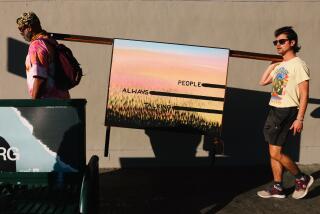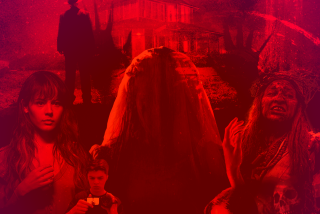A Scroll Through Hell : Folk Paintings From Taiwan Depict the Travails and Torments of the Damned
- Share via
It turns out that “A Journey Through Chinese Hell,” which opens Saturday at Bowers Museum of Cultural Art in Santa Ana, has nothing to do with either soggy egg rolls or the Cultural Revolution.
Think of it more as Dante’s “Inferno,” Chinese style. The focus of the show is two sets of 10 Taiwanese “Hell Scrolls,” each depicting the stages in which souls of the deceased atone for their transgressions before reincarnation. Such scrolls were commonly created by folk artists to be displayed at funerals, as warnings to the living.
“When I first saw these, I thought this was a wonderful introduction to an entire moral and ethical system, succinctly and visually beautifully summarizing a complete folk system,” recalled show curator Paul Michael Taylor.
“It was like reading Dante when I was studying medieval and Renaissance literature in Padua. Only now I was in ‘Asian Ethnology.’ ”
Taylor heads that program at the Smithsonian Institution’s National Museum of Natural History in Washington, where the Hell Scrolls were first shown. No complete set of such scrolls had ever been exhibited in the United States; one of the sets is the oldest known example of the genre.
The Ho Scrolls, named for painter Ho Hsin-yen, date to the early 20th century and are brightly colored. The Hsin Chu Scrolls may be as old as the mid-17th century or as recent as the mid-19th century, and, said Taylor, “have a very subdued color scheme, but stay with you longer.”
The scrolls offer parallel journeys through hell and through the ethical system of traditional Chinese communities, graphically depicting tortures appropriate to each transgression. More than 500 inscriptions identify the specific sin for which punishment is being meted.
This is a bilingual exhibition. The scrolls bear Chinese captions; Taylor’s staff made English labels and line drawings to identify events and punishments.
Writers beware: There are punishments for those who publicize another’s ugly behavior or who publish heterodox books that lead people astray. Readers beware: There are punishments for throwing paper with writing on it into a privy, thereby showing disrespect.
Southern Californians might find such punishments relevant, according to Taylor: “I grew up in Los Angeles, so let’s see. . . . People who form violent gangs are tossed onto a bed of spikes. Looting during fires, a hot iron. Setting forest fires, a burning copper chimney. Incest and adultery, boiling vats of oil. . . . Gossips get their tongues pulled out.”
Arguably less appropriate, inattention in class and siding with one’s wife against one’s mother in a family quarrel rate punishments equal to, or more horrifying than, those for murder and rape. On the other hand, there are rewards for having rescued ants.
“It’s more purgatory than hell,” Taylor said. “It’s supposed to be a learning experience. The scrolls chart the path through hell; afterward the souls are reincarnated. But before that, they’re given a potion to forget the whole process.
“The people who learn from it most are those who follow from afar by looking at the scrolls.”
*
Neal Donnelly collected the hell scrolls while serving as an American foreign service officer in Taiwan and donated them to the Smithsonian Institution. His book about the scrolls serves as the show’s catalog and lends the exhibition its name.
Donnelly notes that the concept of hell came late to China, in the 1st Century, via Indian Buddhism, which had borrowed the idea from Brahmanism. The Taiwanese paintings blend Buddhist, Taoist and Confucian elements and contrast as sharply with Indian hell as they do with Hieronymus Bosch.
Taylor said that when the scrolls were in Washington, D.C., Chinese families would come on a weekly basis, studying one scroll each week. “That was the original intent. At the funeral, families of the deceased would talk about the things that can happen in hell and encourage ethical behavior.”
The show opened at the Smithsonian in September 1990. When the show closed the following March, flaking was discovered. Extensive re-restoration was undertaken, and not completed until April 1995, after which the scrolls traveled to San Francisco and now to Santa Ana.
Most of the scrolls’ restoration problems stem from the fact that they were never intended for posterity; hell scrolls were generally discarded soon after the funeral for which they were made.
“These were folk artists,” Taylor pointed out. “In general, these scrolls were not even made on very strong paper. For some reason, these two were saved.”
(BEGIN TEXT OF INFOBOX / INFOGRAPHIC)
‘Hell’ in Words, Images
Five films and a lecture are scheduled in conjunction with “A Journey Through Chinese Hell.” The films, free with museum admission, begin at 7:30 p.m.
* Jan. 25: “Crows and Sparrows” (black and white, 115 minutes) depicts working-class life in pre-1949 Shanghai.
* Feb. 1: “Myriad of Lights” (black and white, 124 minutes) paints a bleak picture of life in China for an employee who can’t make ends meet.
* Feb. 22: “All Under Heaven” (58 minutes) examines daily life in a north China village in the 1980s.
* March 7: “Plunder of the Peach and Plum” (black and white, 112 minutes) depicts the inequities of 1930s society through the lives of two young college graduates.
* March 10 at 2 p.m.: Lecture, “Chinese Hell.” Gary Seaman, professor of anthropology at USC. Museum members, $5; nonmembers, $7.50, including museum admission.
* March 21: “The Street Players” (118 minutes) is based on a classic story about the struggles of a street performer and his family in the 1930s.
* What: “A Journey Through Chinese Hell: Hell Scrolls of Taiwan.”
* When: Saturday-March 24. Open 10 a.m.-4 p.m. Tuesday-Sunday, Thursday until 9 p.m.
* Where: Bowers Museum of Cultural Art, 2002 N. Main St., Santa Ana.
* Whereabouts: Exit the Santa Ana Freeway at 17th Street; go west. Turn right onto Main Street.
* Wherewithal: $4.50 for adults, $3 for seniors over 62 and students, $1.50 for children 5-12, under 5 free.
* Where to call: (714) 567-3600.
More to Read
The biggest entertainment stories
Get our big stories about Hollywood, film, television, music, arts, culture and more right in your inbox as soon as they publish.
You may occasionally receive promotional content from the Los Angeles Times.










